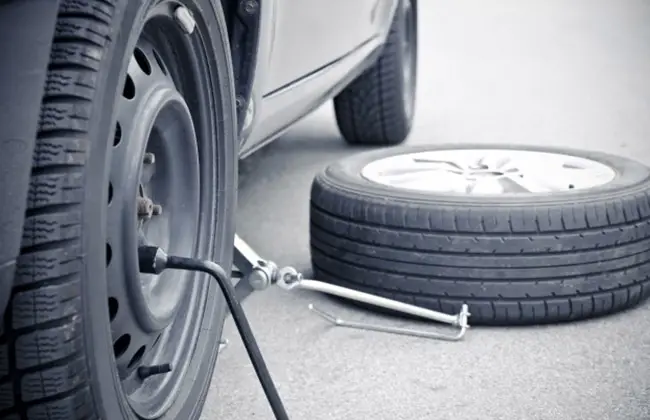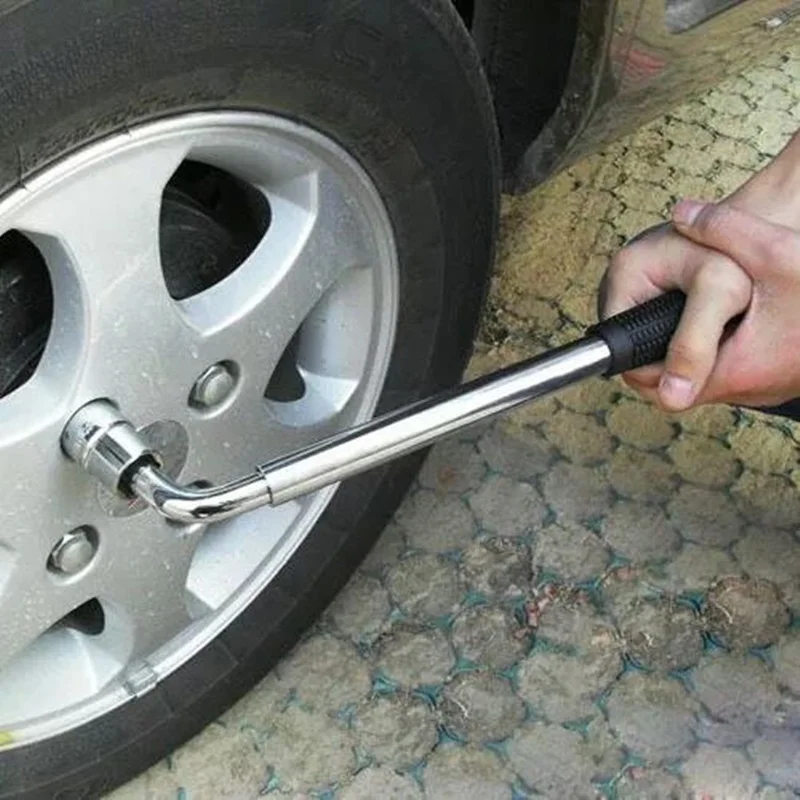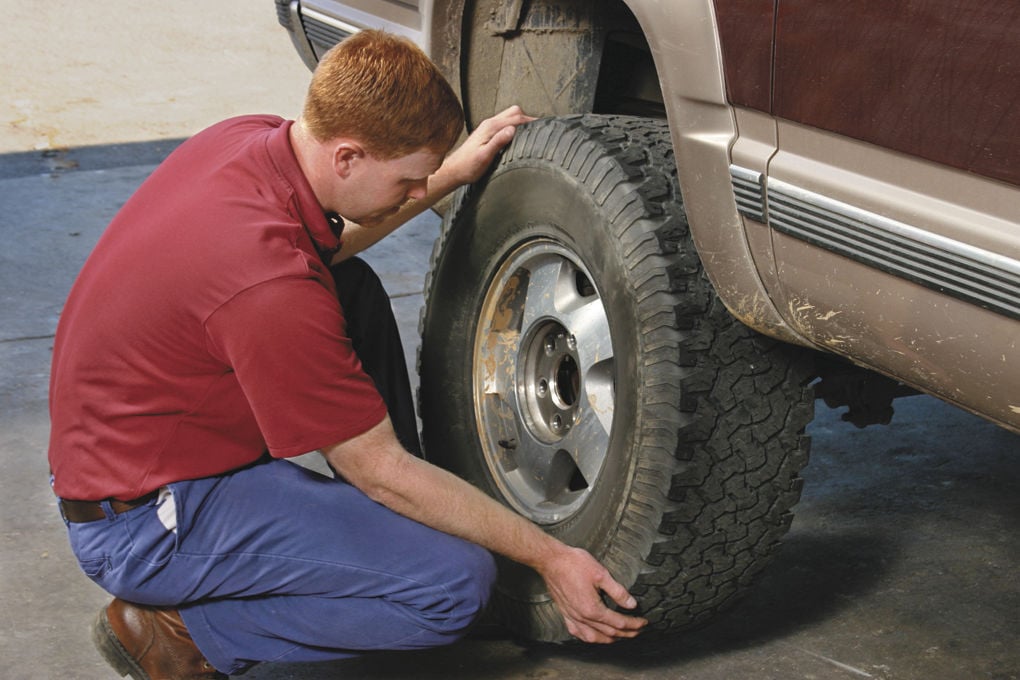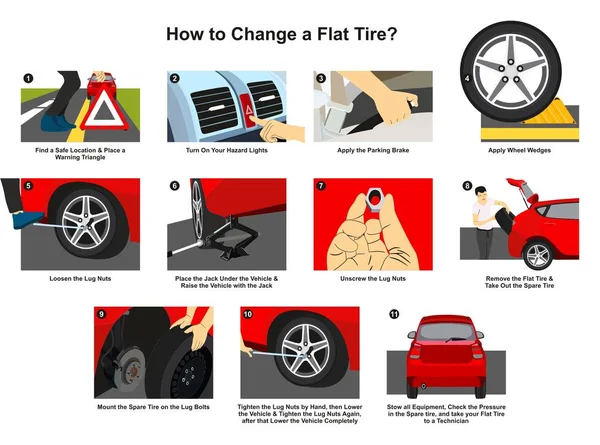Drivers should always be prepared for the unexpected. Knowing what to do in the event of an accident, emergency, or even a flat tire can save you time and money as well as protect you against more serious problems. Do you know how to change a tire if you get stranded? What happens if you don’t have a car jack? Luckily, there’s a solution to every problem.
A bad attitude is like a flat tire, you can't get very far until you change it. pic.twitter.com/RwIWUOdwL9
— Point S Tire & Auto (@pointsauto) July 12, 2019
Being prepared is one of the first duties of owning a car. Your vehicle should always have supplies in the event of an issue. In order to change a flat tire, a car jack is ideal because it easily lifts the tire up and away. But according to It Still Runs, if a jack is unavailable, there are things you’ll need to get the job done:
Other things that can help include gloves, a flashlight, blankets, towels, and rags, and even a tire ramp. Lubrication (light machine oil), a tire pressure gauge, and roadside safety equipment like flares and reflectors are also useful.
If you realize you have a flat, do your best to slowly move your vehicle to a place where the flat tire can be over open soil or earth, with plenty of room to work. Sometimes this is easier said than done. But without a jack, it’s best to do the work somewhere pliable and soft. Turn your car off and engage your emergency brake fully.
First, find something you can use as a blocking tool to slide under the side of the axle closest to the flat tire. This can be a wooden block, large log, tree stump, or something else. Stack these materials up until it makes contact with the axle. Once your blocking materials are in place, start digging away at the soil beneath the flat tire with a tool or your hands. Keep digging until the axle rests solidly on the blocking materials.
Keep digging until the axle rests solidly on the blocking materials.
Once you’re sure your axle is supported, start digging at the soil beneath the flat tire. Shovel out at least a few inches on all four sides of the tire, wide and deep enough to remove the tire and install a new one. With enough room to work, remove the nuts on the tire with a tire iron. According to Jack and Jill of All Tires, using a lug wrench and tire iron make it easier, but lug nuts can be resistant and take time to remove. Pull the rim off the threaded studs and remove the flat tire.
Now it’s time to place your spare tire in the hole you dug. Lift it up onto the studs until each one is poking through the rim. Next, begin threading every nut you removed back onto the studs by hand. Now you can tighten them with the tire iron. As Popular Mechanics explains, it’s important to tighten lug nuts in a crisscross pattern, going across instead of around in a circle. Repeat this process to ensure your lug nuts are secure.
Once your spare tire is securely in place, it’s time to get out of the hole you dug. Try placing two large rocks in front and behind the tire and fill the hole back up with dirt. Disengage your emergency brake, start the car, and put it in forward drive. Slowly try to make your way out of the hole and lift the axle up off the blocking materials. After climbing from the small hole, remember to pick up your supplies and clean up.
Posted by The Art of Manliness on Thursday, November 6, 2008
Safety should always come first. As Bridgestone Tire points out, you should always try to change your tire in a safe place. Never change it on a narrow shoulder, near oncoming traffic, or on any area of road where you’re not clearly visible to other drivers. Turn on your four-way flashers or caution lights, and use other safety measures like cones and flares when necessary.
Knowing how to change a tire is a necessary skill for all drivers. If you rely on a cell phone to save you in a roadside emergency, there’s always that chance you will forget to charge it, be out of range, or leave it at home. Flat tires can happen anywhere, and a cell phone is no substitute for knowing how to change a flat tire.
Thankfully, changing a tire isn’t all that hard! Just adhere to the following guidelines to be prepared in case you have a flat.
These items should have come with your vehicle:
Jack
Lug wrench
Fully inflated spare tire
Vehicle owner’s manual
If you have misplaced any of these items, or if your car did not come with these items, you should purchase new ones right away. And be sure you’re regularly inflating the spare tire to your vehicle manufacturer’s recommended PSI. You should check the spare’s air pressure every time you check your other tires. Remember to check pressure every month and before long trips or carrying extra load.
Remember to check pressure every month and before long trips or carrying extra load.
Here are some items that don’t come with your vehicle but that you should stow in your trunk or glove box in case you have to change a flat tire:
Flashlight with working batteries
Rain poncho
Small cut of 2"x6” wood to secure the jack
Gloves
Wheel wedges
As soon as you realize you have a flat tire, do not abruptly brake or turn. Slowly reduce speed and scan your surroundings for a level, straight stretch of road with a wide shoulder. An empty parking lot would be an ideal place. Level ground is good because it will prevent your vehicle from rolling. Also, straight stretches of road are better than curves because oncoming traffic is more likely to see you.
Never attempt to change your tire on a narrow shoulder near oncoming traffic. Keep moving (slowly) until you find a safer spot. While driving on a flat risks ruining your rim, replacing a rim is better than being hit by an inattentive driver.
Make sure to consult your owner’s manual and review their specific steps on how to change a flat tire for your vehicle
Your hazard lights or “flashers” will help other drivers see you on the side of the road. To avoid an accident, turn them on as soon as you realize you need to pull over.
Once stopped, always use the parking brake when preparing to replace a flat tire. This will minimize the possibility of your vehicle rolling.
Wheel wedges go in front of or behind the tires to further ensure the vehicle doesn’t roll while you fix the flat tire. If you’re changing a rear tire, place these in front of the front tires. If your flat tire is at the front, put the wheel wedges behind the rear tires.
Bricks or large stones will work just as well as “real” wheel wedges. Just be sure they’re large enough to stop the car from rolling.
If your vehicle has a hubcap covering the lug nuts, it’s easier to remove the hubcap before lifting the vehicle with the jack. If your lug nuts are exposed, you can skip ahead to Step 6.
If your lug nuts are exposed, you can skip ahead to Step 6.
Use the flat end of your lug wrench to remove the hubcap. This will work for most vehicles, but some hubcaps need a different tool to come off. Consult your owner’s manual for proper hubcap or wheel cover removal procedures.
Using the lug wrench, turn the lug nuts counterclockwise until you break their resistance. You may have to use force, and that’s ok. Use your foot or all of your body weight if necessary.
Loosen the lug nuts about ¼ to ½ of a turn, but don’t remove them completely yet. Save that for when it’s time to remove your tire/wheel from the vehicle.
The right place for the jack is usually beneath the vehicle frame alongside the tire that’s flat. Many vehicle frames have molded plastic on the bottom with a cleared area of exposed metal specifically for the jack. To safely lift and avoid damage to the vehicle, follow the instructions for jack placement in your vehicle owner’s manual.
To prevent the jack from settling under the weight of your vehicle and coming off balance, place a small cut of 2x6” wood beneath it before attempting to raise your vehicle. This tactic is especially helpful on asphalt.
With the jack properly positioned, raise the vehicle until the flat tire is about six inches above the ground.
Never put any part of your body under the vehicle during or after raising the vehicle with the jack.
Now it’s time to remove the lug nuts all the way. Since you've already loosened them, you should be able to unscrew them mostly by hand.
Gripping the tire by the treads, pull it gently toward you until it’s completely free from the hub behind it. Set it on its side so that it doesn’t roll away.
Now place the spare on the hub by lining up the rim with the lug bolts. Push gently until the lug bolts show through the rim.
Put the lug nuts back on the lug bolts and tighten them all the way by hand. Once they are all on, check each one again, tightening as much as possible. You will tighten them with the wrench after lowering the vehicle to the ground.
Use the jack to lower the vehicle so that the spare tire is resting on the ground but the full weight of the vehicle isn’t fully on the tire. At this point, you should tighten the lug nuts with the wrench, turning clockwise, as much as you can. Push down on the lug wrench with the full weight of your body.
Bring the vehicle all the way to the ground and remove the jack. Give the lug nuts another pull with the wrench to ensure they’re as tight as possible.
If the hubcap you took from the flat tire will fit your spare, put it in place the same way you removed it initially. If it doesn’t fit, stow it away with the tire when you stow your equipment.
If it doesn’t fit, stow it away with the tire when you stow your equipment.
You have before you a jack, a lug wrench, wheel wedges, your flat tire, and possibly a hubcap. Don’t forget to put all of them in your vehicle before driving away.
You should check the tire pressure of the spare tire to make sure that it is safe to drive on. “T-Type” temporary spares, also called “mini-spares,” require 60 psi (420 kPa). If the tire needs pressure, drive (slowly) to a service station immediately.
Temporary spare tires aren’t made to drive long distances or at high speeds, so drive cautiously until you’re able to visit a tire technician. A professional should be able to determine whether your tire needs a repair or if it’s time to replace it.
Aside from taking your tire to a professional, the above procedure shouldn’t take more than 15 to 30 minutes to change a tire. Just be sure you don’t leave out any steps.
Just be sure you don’t leave out any steps.
It’s beneficial practice changing a tire in your garage or driveway to ensure you’re ready to handle this situation if it ever happens to you.
Knowing how to fix a flat tire is great, but regular tire maintenance is even more important. In addition to reviewing this guide regularly, remember to do the following:
Keep your tires properly inflated
Rotate your tires according to the manufacturer’s guidelines
Monitor for tread wear
All of these precautions will extend the life of your tires and reduce the likelihood of a flat. While there’s no way to prevent flat tires completely, proper care can improve performance and ensure your tires last as long as possible.
There’s never a good time for a flat. That’s why Bridgestone DriveGuard tires are masterfully engineered to keep you moving for up to 50 miles at speeds up to 50 MPH without disruption.
There’s never a good time for a flat. That’s why Bridgestone DriveGuard tires are masterfully engineered to keep you moving for up to 50 miles at speeds up to 50 MPH without disruption.
See Details Find Your Fit
22 April 2017 Likbez Do it yourself
The ability to change wheels will never be superfluous. Moreover, the process itself takes 10–15 minutes, and everything you need is usually in the trunk of any car.
A punctured tire is usually indicated by noise from outside, as well as loss of speed and poor handling. If the car pulls to the side, and in order to keep it on the road, you have to make an effort, then most likely a puncture on one of the front wheels. If the back of the car starts to skid, then the problem is there.
If the back of the car starts to skid, then the problem is there.
When this happens, you will know exactly what it is. Don't panic by any means. Align the car and, gradually reducing speed, pull over to the side of the road.
You can't drive with a punctured tire, but it's also not a good idea to stop in the middle of the road. Therefore, do not be afraid to drive a couple of tens of meters and choose a flat, dry place on the side of the road.
It is best to stay away from moving traffic so as not to cause an accident and risk your life.
Drivers of cars with a manual transmission must always engage first gear, and owners of automatic transmissions must shift the lever to the park (P) position.
And in any case, you need to put the car on the handbrake.
After parking the car in a safe place, do not forget to turn on the hazard warning lights and install the warning triangle located in the trunk. In settlements, it is placed 20 meters behind the car, and on the highway - 40 meters.
In settlements, it is placed 20 meters behind the car, and on the highway - 40 meters.
In the same place, in the trunk, find a spare wheel and a jack with a wheelbrace. Usually the manufacturer places all this in a special niche under the floor, which can be reached by lifting the bottom panel.
It is good if you have a pump and a pressure gauge with you, as well as wheel chocks. And, of course, gloves will not interfere, since you still have to get your hands a little dirty.
After removing all the tools and spare tire, place them next to the punctured tire and ask all passengers to get out of the car. Even if it's freezing cold or pouring rain outside, safety comes first.
Despite the handbrake and the gear engaged, before installing the jack, you must additionally fix the wheels with stops. For them, however, any stones or pieces of brick will do.
If the rear wheel needs to be replaced, the chocks are placed on both sides of the front wheels and vice versa.

You are now ready to remove the wheel. First, remove the disc from the plastic cap and use the wheelbrace to loosen the bolts. To move them from their place, you will need a lot of effort, which can be provided by the weight of your body by simply pressing on the key with your foot. It is not necessary to completely unscrew the bolts: it is enough to unscrew them one turn.
The machine must then be jacked up. In no case should you install it anywhere. Especially for these purposes, there are small reinforced places on the bottom, which are usually located behind the front wheel or immediately in front of the rear. The manufacturer designates them using triangles or cutouts at the bottom of the thresholds. If the weld is covered with plastic pads, they will break at the jacking points.
Place the jack under the bottom and start turning the jack handle clockwise. Be sure to make sure that the jack rises evenly, does not heel.
If under the weight of the machine the lower foot of the jack sinks into the ground, you need to put something like a piece of board or brick under it.

Do not raise the wheel too much. It is enough to stop 5 cm from the ground. After that, you can completely unscrew the bolts and remove the punctured wheel from the hub. It is better to slide it under the car as insurance, and put the bolts somewhere on a rag so that they are not lost.
It remains to replace the punctured wheel with a spare. To do this, align the holes on the disc with the holes in the hub, put the wheel on and screw on the bolts, completely wrapping them by hand.
It is important to install the nuts that fasten the wheels to the hub with the semicircular side towards the rim, and not out.
Remove the punctured wheel from under the machine, lower the jack and finally tighten the bolts. You need to do it right. On wheels with four or six holes, opposite bolts are tightened in pairs. If there are five holes, then you need to pull in this order, as if you are drawing a five-pointed star.
It remains to assemble the tool, remove the jack and stops, and also check the pressure in the installed wheel and, if necessary, pump it up. If the pump is not at hand, you can ask for help from passing drivers.
If you are using a small spare tire, the so-called stowaway, then remember to be careful: it can usually be driven at a speed of no more than 80 km/h and for a maximum distance of 100 kilometers.
And, of course, try to repair a punctured wheel as soon as possible in a specialized tire shop, so as not to tempt fate and not drive without a spare wheel.
fourwheeler.com
A car jack is taken for granted. And the situation becomes all the more difficult when, at the most inopportune moment, it turns out that it is out of order (or missing), and somehow you need to change the wheel.
Maxim Stroker
Anything happens in life. The author of these lines, for example, once bought a used car from a wildly stingy man: he even quietly pulled a jack and a balloon wrench out of the trunk before closing the deal. It's good that this nuance was discovered before the wheel puncture that happened a week later, but what if not?! The best way to do without your own jack is to stop a passing car and take advantage of the kindness of its driver. But now go stop someone, and it is quite possible to puncture a wheel not on the asphalt of the federal highway, but also somewhere on a forest path, on which cars only appear every few days. But if necessary, you can change a punctured wheel without using a jack. The first way is as follows. You need to build or find a small hill - for example, a mound of earth, a log or a small stone. Next, we quickly pump up the wheel and drive it onto our improvised "flyover". After that, the experts of the AutoVzglyad portal recommend placing some kind of reliable stop under the body of the car so that after removing our “flyover” the car remains with the wheel hanging in the air.
nttsbreakdown.ca
And it is absolutely necessary to insure the car against rolling in one way or another. Now, in order to replace the wheel, we remove the "flyover", dismantle it and replace it with a previously deflated "spare tire". After that, it remains to pump up the newly installed wheel and remove the stand from under the car, on which it hung during the replacement process. On soft ground, if you have some kind of entrenching tool at hand, something similar can be depicted by inflating the punctured wheel to the maximum, slipping a long log under the hull next to it. After that, we blow off the damaged tire and dig under it a hole of such depth and size that we can dismantle the affected wheel. We replace it with a deflated spare tire, pump it up and move on.
You can, of course, lift the car with the help of a lever, for example, a long pole slipped under the bottom, resting on, again, a large stone or log. But in this case, you need to remember that without consequences for the integrity of the body, only a frame SUV can be lifted by this method.